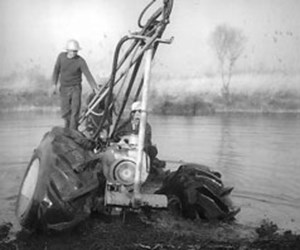What's New in Exploration
Seismic, the foundation tool of oil and gas exploration, has some reflecting to do about its future, not will it work, or can exploration seismic become “better,” but is it becoming necessary at all? Exploration, in light of unconventional reservoirs, has been facing that question for some time. Finding any new resource (oil, gas, gold, technology, water, air, better neighborhoods) is a challenging effort or process. Exploration starts with risk-taking, not just investment money. Then explorationists must gather real data, exercise judgement, show professionalism, and maybe use advanced technology.
Training programs of yore. You may not know that once upon a time, all majors had training programs, where the eligible geos [rocks and digit-heads] were trained in the field on jug crews or drilling rigs, and in seismic processing leading to interpretation, BEFORE being allowed to decide the what and where. Amoco’s program was formal and three years in duration. Others were five years. After the “outsourcing” of the 1980s, majors relied on the independents to train. Further to the outsourcing, independents relied on older, outsourced people from the majors for prospecting, while hoping the service companies trained younger folks in the basics. When the service companies went into the tank, no one trained. Yet, with the emerging phenomenon of company-saving multi-client seismic data, all oil and gas exploration, especially offshore, was blasted into modern practice.
One should ask, where is the training now? I would gander that other than universities like Calgary and Houston, some training is occurring at service companies, but mainly none occurs at all, save for one-week classes on application of the latest workstation software. I see little hope for a positive change to actual training of humans. There is an effort at AI to make up for the lack of this experience and to sit in the decision chain, somewhere and often, as I have reported. It is a wonder that we find anything. We know a few engineers who do not use seismic at all for production purposes. There are entire operators doing the same. So how does the large impact of the horizontal work affect the seismic industry?
Seismic history. The Chinese claim to have the first use of a seismograph a few thousand years ago—a bowl of water. Many have since dabbled in its creation. John C. Karcher is credited for reflection seismic, and R. Fessenden for marine seismic acoustics. However, when Ludger Mintrop in World War I made military use of active seismic as a way to locate Allied artillery, funding and then science became seriously involved. In the 1930s, E. W. Marlin of Ponca City, Okla., hired a crew to record the new imaging science and swore that the lows between sections of 100% analog seismic were oil traps and drilled a few, creating Conoco. We know that once NMO was invented, those lows were highs. Also in the 1950s, how to use what seismic source when, and where, became, and still is, an issue if you want to do seismic at all.
Along came CDP in the 1960s, a few years before massive digital computers. A computer before the “digital age” was a person who calculated recorded bits and plotted them, one at a time, on new film using a mechanical device similar to a spring-loaded slide rule. In the mid-1970s, 3D appeared; today everyone swears by it. Now, there is a lot of swearing over the use of 4D, attributes, amplitudes and such.
All of these technical improvements were aimed at structure and stratigraphic imaging, and indirect detection of movable fluids. Places where we are spending money on “sort-of exploration”: Almost nowhere, when considering the rig count and the projects involved. Trends do not appear to be in favor of more new areas. Wildcatting exploration may be less than 1% to 2% of rig count in any given month.
Technology we are spending money on: Reprocessing 3D data sets to reduce noise, and splitting volumes into low frequency and moderate frequency (it remains an illusion to think that conventional air-gun marine data are high-frequency or ultra-low-frequency). Attribute inversion and rock properties continue to evolve, as do improvements to acoustic signal processing in general, especially in elastic/vector space. Unfortunately, as these methods improve, the market of users is declining—significantly.
The big “however” is that a few folks see opportunity where others only see Wall Street. Who is spending the most on exploration technology, mainly to catch up? They are, in this order: China, Saudi Arabia, India, Russia, Europe (Norway, France, the UK and Italy, combined). Somewhere down the expense line are Canada, Australia, the U.S., and maybe Colombia. Then, lastly, is New Zealand. Venezuela is out. Brazil is out (for now). Africa was never a techno player, except briefly in Egypt, Algeria, Libya and Morocco—but no others south along either coast. I applaud the Republic of South Africa for thinking about oil and gas. What, you say? I left out many places? Most countries outside the U.S. are risk contract-based, relying on outside technology and outside money or government intervention. They are not spending on technology, you are. ![]()

- The reserves replacement dilemma: Can intelligent digital technologies fill the supply gap? (March 2024)
- What's new in exploration (January 2024)
- Dallas Fed: E&P activity essentially unchanged; optimism wanes as uncertainty jumps (January 2024)
- Quantum computing and subsurface prediction (January 2024)
- What's new in exploration (September 2023)
- Machine learning-assisted induced seismicity characterization of the Ellenburger formation, Midland basin (August 2023)



